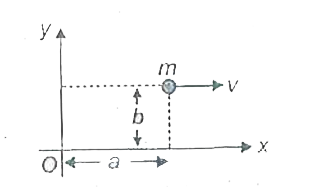A particle of mass m starts moving from origin along a horizontal x-y plane under the influence of a force of constant magnitude F ( which is always parallel to the x-axis ) and a constraint force. The trajectory of its motion is . Then,
work down by the force F during the motion from x = 0 to x = 1 m is
work done by the force F during the motion from x = 0 to x = 1 m is ( F ) Nm
final velocity of the particle is
final velocity of the particle is
The correct Answer is:B, C
To solve the problem step by step, we will analyze the motion of a particle of mass m moving under the influence of a constant force F along a trajectory defined by the function f(x)=xx2+1. We will find the work done by the force and the final velocity of the particle.
Step 1: Understanding the Work Done by the Force
The work done W by a force F when the particle moves from position x=0 to x=1 can be calculated using the formula:
W=∫x2x1Fdx
where x1=0 and x2=1.
Step 2: Setting Up the Work Integral
Since the force F is always parallel to the x-axis, we can express the differential work done dW as:
dW=Fdx
Thus, the total work done from x=0 to x=1 is:
W=∫10Fdx
Step 3: Evaluating the Work Done
Integrating the expression, we have:
W=F∫10dx=F(x)10=F(1−0)=F
So, the work done by the force when the particle moves from x=0 to x=1 is:
W=F (in Joules)
Step 4: Applying the Work-Energy Theorem
According to the work-energy theorem, the work done on the particle is equal to the change in kinetic energy:
W=ΔKE=KEf−KEi
Since the particle starts from rest, the initial kinetic energy KEi=0. Therefore:
W=KEf−0=KEf
Step 5: Expressing Kinetic Energy
The kinetic energy of the particle can be expressed as:
KEf=12mv2
where v is the final velocity of the particle. Setting the work done equal to the final kinetic energy:
F=12mv2
Step 6: Solving for Final Velocity
Rearranging the equation to solve for v:
v2=2Fm
Taking the square root gives us the final velocity:
v=√2Fm
Summary of Results
1. The work done by the force F when moving from x=0 to x=1 is W=F.
2. The final velocity of the particle is given by v=√2Fm.
The work done W by a force F when the particle moves from position x=0 to x=1 can be calculated using the formula:
W=∫x2x1Fdx
where x1=0 and x2=1.
Since the force F is always parallel to the x-axis, we can express the differential work done dW as:
dW=Fdx
Thus, the total work done from x=0 to x=1 is:
W=∫10Fdx
Integrating the expression, we have:
W=F∫10dx=F(x)10=F(1−0)=F
So, the work done by the force when the particle moves from x=0 to x=1 is:
W=F (in Joules)
According to the work-energy theorem, the work done on the particle is equal to the change in kinetic energy:
W=ΔKE=KEf−KEi
Since the particle starts from rest, the initial kinetic energy KEi=0. Therefore:
W=KEf−0=KEf
The kinetic energy of the particle can be expressed as:
KEf=12mv2
where v is the final velocity of the particle. Setting the work done equal to the final kinetic energy:
F=12mv2
Rearranging the equation to solve for v:
v2=2Fm
Taking the square root gives us the final velocity:
v=√2Fm
1. The work done by the force F when moving from x=0 to x=1 is W=F.
2. The final velocity of the particle is given by v=√2Fm.
Similar Questions
Knowledge Check
A mass M moving with a constant velocity parallel to the X-axis. Its angular momentum with respect to the origin
Aa. is zeroBb. remains constantCc. goes on increasingDd. goes on decreasing
A particle moves along X-axis from x=0 to x=1 m under the influence of a force given by F=3x2+2x−10. Work done in the process is
View SolutionA particle of mass m moves on positive x-axis under the influence of force acting towards the origin given by −kx2ˆi. If the particle starts from rest at x=a, the speed it will attain when it crosses the origin is
View SolutionA particle moves along x-axis from x=0 to x=2 m under the influence of a force F (in N) given by F=3x2+2x−5. Calculate the work done
View SolutionA particle moves along the X-axis x=0 to x=5 m under the influence of a force given by F=10−2x+3x2. Work done in the process is
View SolutionA particle of mass m is moving with speed u. It is stopped by a force F in distance x if the stopping force is 4 F then
View SolutionA particle of mass m is moving with constant velocity v parallel to the x-axis as shown in the figure. Its angular momentum about origin O is

View SolutionA particle moves along the X-axis from x=0 to x=5 m under the influence of a force given by F=7−2x+3x2. Find the work done in the process.
View Solution
